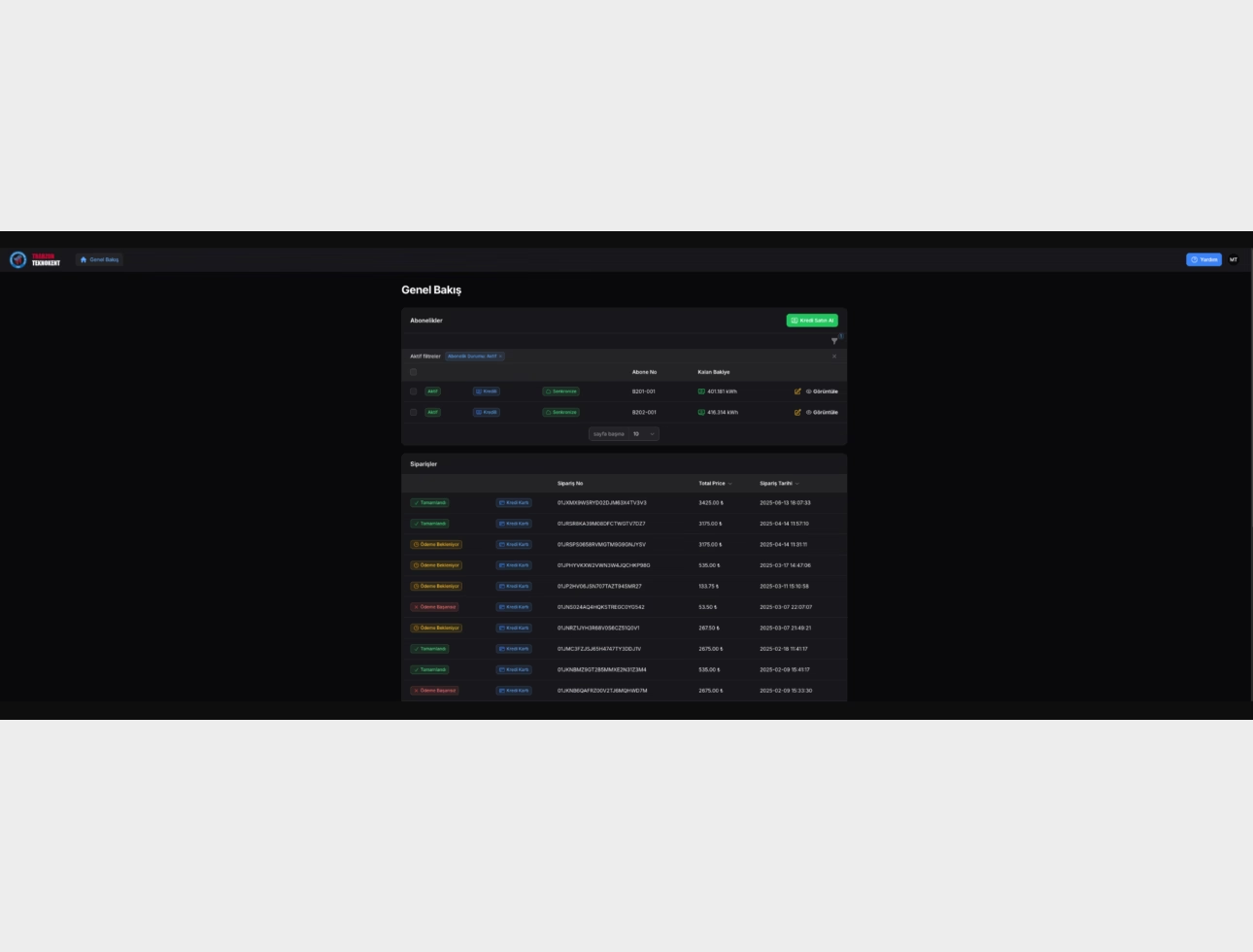This system primarily functions as a credit meter reading and management system. It integrates high-frequency meter data collected from the field into a central system via collectors and RF modems, offering real-time monitoring, advanced reporting, and effective operational control capabilities. This platform is developed to increase energy efficiency, reduce operational costs, and maximize grid reliability. With its credit system structure, subscribers' energy consumption and balance can be tracked instantly, and energy cut-off/reconnection operations can be managed automatically or manually based on payment status.
Key Functions and Features:
Credit Subscriber and Meter Management: The system centrally manages the credit status of subscribers and meters. It instantly monitors each meter's current credit amount, consumption, and current status. When credit falls below a certain limit, automatic warning emails are sent to subscribers, and a convenient credit purchase option via credit card is offered through the web application. If credit runs out or falls below a certain limit, energy cut-off/reconnection commands are transmitted to meters automatically or manually. Key performance indicators such as total subscriber count, payment amounts, and consumed energy provide detailed information for financial and operational decisions. Subscribers can be segmented as invoiced, credit, warning limit, or no energy. The system can perform detailed analysis on purchased credits and issue relevant invoices. Subscriptions can be easily terminated, and the same office or shop can be quickly and effectively assigned to another subscriber.
Pricing Management: The energy kWh price sold by the company can be easily and dynamically changed via the energy pricing screen. This offers flexibility to adjust prices according to market conditions or company policies.
User and Role Management: Users with different authority levels (Developers, Operators, Administrators) can be defined in the system, their information can be managed, edited, and removed from the system. Access to the system and data manipulation are controlled through specific authorizations defined for each role. Special API keys can be allocated and managed for users for specific operations.
Company and Field Management: The hierarchical structure of energy distribution companies and their subordinate branches and operational fields is defined and managed in detail within the system. Companies' contact information, operational parameters such as maximum meters per RF module, and API usage permissions can be centrally regulated. Field locations can be determined on a map to facilitate visualization and management of operational areas.
Data Collector Management: Data collector units (such as REACH-HD) deployed in the field are registered in the system, and their active status, IP addresses (both IPv4 and IPv6), communication port numbers, and software versions can be monitored instantly. The synchronization status and dates of collectors with the central AMI Web Service are tracked to ensure continuous data flow.
RF Module Management: RF modems (including models supporting 868 MHz and 2.4 GHz frequencies like U-MOTE and Mahmote) in the field are defined in the system, and their detailed information (serial number, IP address, meter reading period, number of connected meters, active status, error status, and synchronization date) is tracked. Synchronization records sent by RF modules at specific periods are examined to verify the operational and connection health of the modules. Settings such as RF module reading periods can be configured remotely.
Meter Management and Advanced Data Analysis: Electronic meters are registered in the system, and information such as serial number, associated RF module, active status, last reading, and OBIS reading dates are tracked. Values belonging to OBIS (Object Identification System) codes read from meters (energy, voltage, current, etc.) are listed in detail. Load profile data (fragmented and integrated) is stored in the system, enabling detailed energy consumption analysis and trend determination. Meter fault records detected by RF modules are automatically recorded and can be tracked with information such as fault type, start/end date. Raw meter data from collectors can be reviewed before processing, and matching statuses can be updated for data integrity. Graphs of critical grid parameters such as Capacitive Reactive ratio and Inductive Reactive ratio can be created based on meter data.
Communication and Transaction Records: Details and sending history of emails (system reports, meter fault notifications) and other communications generated by the system and sent to users are stored. All operational transactions performed by collector units (meter reading, relationship addition, RF module setting updates, etc.) are kept in detailed logs. All addition, update, and deletion (manipulation) operations performed within the system are recorded as "Daily Entries" with information on who performed them, on which object, and when, ensuring auditability and security.
API Documentation: Detailed technical documents about the system's API (Application Programming Interface) are provided for developers and company managers. These documents contain information about authentication processes, API endpoints, and data models.
Advantages:
Real-time Grid Visibility: Provides in-depth insights into the energy grid with instant data flow from meters and devices in the field.
Operational Efficiency: Reduces the need for field visits and manual intervention through remote meter reading, fault detection, and device management.
Advanced Data Analysis: Supports decision-making processes by performing detailed analyses with load profile, OBIS data, and fault records.
Robust and Reliable Infrastructure: Uninterrupted and secure data communication with RF Mesh technology and comprehensive logging/monitoring features.
User-Friendly Interface: Easy system management with a detailed and clear web interface.
Flexibility and Scalability: Offers a adaptable and expandable structure suitable for different company structures and field needs.
